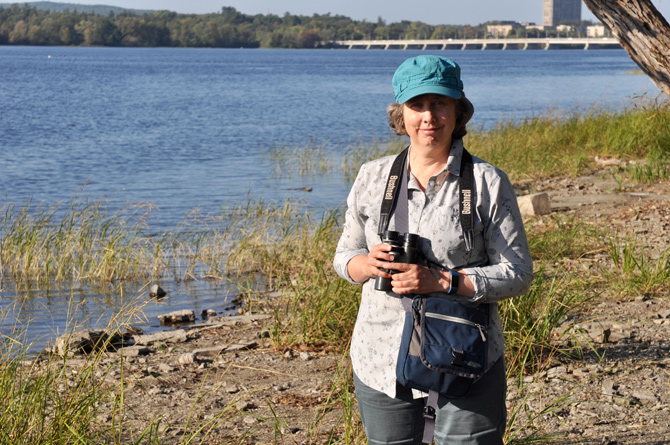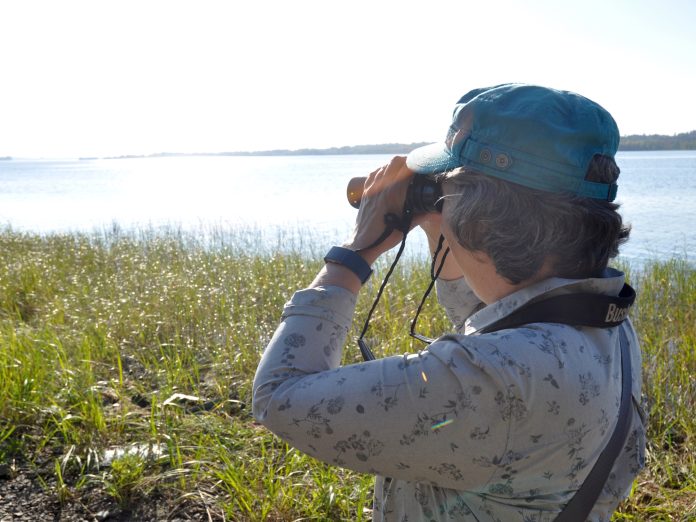By Andrea Prazmowski –
Bev McBride is being interviewed and giving the conversation her full attention, but doesn’t miss a beat when asked what birds she’s noticing, on the shore of the Ottawa River downstream from Westboro Beach. Like rapid-fire, she lists them.
“I hear American Goldfinches over there,” she says, gesturing to the vegetation on her left. “Northern Cardinals in the shrubs along there,” further up the bike path. “Song sparrows all along here, and those are Ring-billed Gulls out on the water.”
Her ears and eyes finely-tuned by decades of birding, Bev’s observations are a revelation to a non-birder, ears straining to discern the Goldfinches’ chirps amidst the thrum of insects and sounds of the river.

Together with her partner Dave Moore, Bev leads local excursions for the Ottawa Field-Naturalists Club and has made numerous birding trips in Canada and abroad. Yet she knows there’s a treasure trove right here, not far from at her Tweedsmuir Avenue door.
“I love the Ottawa River. I know I’m really fortunate to live so close to it and be able to come here anytime to look for birds.”
In fact, this section of river and shoreline is designated an Important Bird and Biodiversity Area (IBA) by BirdLife International, for being globally important for the conservation of bird populations. The Lac Deschenes-Ottawa River IBA covers a stretch of river and shoreline from Quyon, Quebec almost to the Chaudiere rapids.
Nature Canada works with BirdLife International to identify IBAs and develop conservation plans. According to Ted Cheskey, Senior Conservation Manager with Nature Canada, this IBA encompasses important habitat for species at risk, and reflects the need for connectivity to other major nature features such as Gatineau Park and the Greenbelt. It’s important for the sheer numbers of certain species that pause for part of their life cycle here or pass through, including Red-throated Loon, Brant, Herring Gull, Greater Black Backed Gull, and Chimney Swift.
The IBA provides food, shelter, nesting areas and roosting areas for the birds. While birding hot spots like Mud Lake are outside the Kitchissippi neighbourhood, we have several key places here as well. Bate Island, at the Champlain Bridge, is notable for water fowl, such as Common Golden-Eye ducks. For many years Bev coordinated the local sector of the Christmas Bird Count (an international census of birds) and one year the volunteers noted 500-1000 Common Golden-Eye roosting at Lemieux Island. It’s also a significant spot for Ring-Billed Gulls and Double-crested Cormorants, whose numbers are on the rise in the IBA.
Nature Canada developed a conservation plan for the IBA in 2014 and identified key threats to the birds, including the increasing recreational use of the river and the loss of chimneys which Chimney Swifts use to roost.
Fall migration is underway for many species, and fall recreation for humans. When migrating birds pause here during a long trip from the Arctic. “They use their stops to re-fuel,” says Bev, “so if they’re constantly disturbed and fly up and land again, they’re using up their energy stores.” Being aware of the birds, and keeping ourselves and our pets at a distance, can help the birds complete their migration successfully.
For birds, the IBA offers food, shelter, a safe place to raise children, and some undisturbed time to rest. Something we can all relate to.
This article is part of a series about environmental initiatives in Kitchissippi ward. We welcome your ideas and feedback! Contact editor@kitchissippi.com. Read other articles in this series right here.
